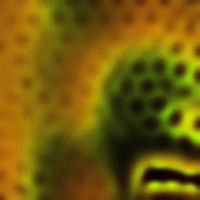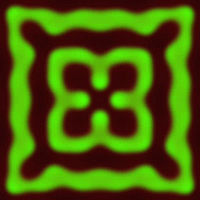Evolutionary Games and Population Dynamics/Selection-diffusion

The dynamics of ecological public goods in continuous spatial settings reveals a fascinating world of dynamical pattern formation. Spatial patterns can unfold if defectors diffuse (migrate) faster than cooperators, \(D_D \leq D_C\). Increased migration rates of defectors are motivated by the fact that defectors deplete common resources (or are unable to sustain them) and this causes them to move elsewhere. Conversely, migration rates of cooperators should be lower in order to enable them to take advantage of the locally sustained common resource. Consequently, the dominant effect of spatial dynamics is not cooperators outrunning defectors, but instead, the defectors' relentless search of productive patches. Slow migration facilitates aggregation of cooperators, whereas fast migration supports defectors to readily locate cooperator patches, but it also impedes their ability to exploit one particular patch.
If cooperators and defectors can co-exist in a stable equilibrium in the absence of space, this does not necessarily imply that the corresponding spatially homogenous state is stable as well. In the vicinity of the equilibrium, the spatial dynamics may take on the form of an activator-inhibitor system. Any deviation from the equilibrium is amplified by cooperators (activators) but suppressed by defectors (inhibitors). If defectors migrate (diffuse) faster than cooperators, these antagonistic forces may give rise to the formation of complex patterns (diffusion induced instability or Turing instability). Any small local disturbance propagates through the system and induces stable heterogeneous strategy distributions. Local disturbances may give rise to rearrangements of the patterns but then quickly relax into another qualitatively indistinguishable distribution of cooperators and defectors.
Conversely, if the co-existence equilibrium is unstable, then spatial extension and migration often prevents extinction and stabilizes co-existence of cooperators and defectors either in static spots and stripes similar to Turing patterns or in chaotic dynamics of ever changing patterns. In general, homogeneous populations near the co-existence equilibrium exhibit periodic density oscillations of increasing amplitude that eventually result in extinction. However, any small local disturbance can propagate through space and trigger stationary, heterogeneous strategy distributions. The pattern formation is again driven by the opposing forces of cooperators (activators) and defectors (inhibitors). However, the activator-inhibitor system develops in the vicinity of an unstable fixed point, which could be termed 'diffusion induced co-existence' complementing the classical 'diffusion induced instability' of Turing patterns. Also note that while Turing patterns rely on substantial differences in the diffusion constants of activators and inhibitors, this does not apply to diffusion induced co-existence, where dynamic patterns emerge even for \(D_D = D_C\).
Individuals consuming common resources, such as in Hardin's Tragedy of the commons, or producing common resources may alter and shape their environment in an enduring manner. This is particularly evident in microbial systems involving extracellular products such as in antibiotic resistance, biofilms or swarming and represent crucial determinants of microbial ecology. Spatial ecological public goods model concurrent spontaneous habitat diversification and species co-existence and hence suggest a mechanism to promote biodiversity.
Modes of pattern formation
The rich dynamics of Ecological Public Goods in spatial settings can be explored by interactive simulations or visualized through movies of high accuracy simulations. Clicking on the images loads interactive real-time EvoLudo simulations that illustrate the characteristics of the corresponding dynamical regime. Because the simulations require significant computational power, high resolution movies are provided as an alternative (requires Quicktime 7 or higher - movies are H.264 encoded). The densities of cooperator and defectors across space are indicated by the brightness of the green and red color components, respectively. Thus, regions of co-existence appear yellow and black regions are vacant. The initial configuration is a disk of homogeneous cooperator and defector densities centered in an empty plane (no-flux boundaries).
| Cooperator density: | Low High
|
|---|
| Payoffs: | Minimum Maximum
|
|---|

Spatio-temporal chaos
Ecological Public Goods Games in spatial settings can exhibit chaotic dynamics and produce fascinating ever changing patterns. This movie illustrates the onset of chaos when starting from a symmetrical initial configuration. The deterministic dynamics should, in principle, preserve the symmetry but instead the symmetry is maintained only for some time and then breaks down due to limitations of the numerical integration. The exponential amplification of arbitrarily small disturbances is the hallmark chaotic systems. In the absence of spatial dimensions the population would be unable to persist.
High resolution movie of spatial chaos (high accuracy integration, 4.1MB).

Intermittent activity
Between the regimes of chaotic dynamics and static patterns an interesting region of intermittent activity occurs: The formation of quasi-static patterns alternates with rapid changes leading to global rearrangement and redistribution of cooperators and defectors. This movie illustrates the successive periods of stasis with intermittent bursts of activity. At first the bursts are synchronized across space but this breaks down over time generating states where large parts are largely static but get regularly stirred up by a wave of change.
High resolution movie of intermittent activity (high accuracy integration, 4.1MB).

Diffusion induced instability - Turing patterns
In the absence of space, cooperators and defectors can co-exist in a stable equilibrium Q. In spatial settings, the corresponding homogeneous strategy distribution is often unstable. Diffusion (or migration) generates an activator-inhibitor system that leads to spontaneous pattern formation also known as Turing patterns. Any deviation from Q is amplified by cooperators (activators) but suppressed by defectors (inhibitors). These antagonistic forces give rise to the formation of complex patterns. Any small local disturbance propagates through the system and induces stable heterogeneous strategy distributions. Further local disturbances may give rise to rearrangements of the patterns but then quickly relax into another qualitatively indistinguishable distribution of cooperators and defectors. In the movie, the inhomogeneity of the initial configuration triggers the formation of Turing patterns.
High resolution movie of intermittent activity (high accuracy integration, 0.5MB).

Diffusion induced coexistence
In the absence of space, the co-existence equilibrium Q is unstable such that cooperator and defector frequencies exhibit oscillations with increasing amplitudes until eventually the population goes extinct. In spatial settings with diffusion, cooperators and defectors again form an activator-inhibitor system but this time emerging spatial patterns are responsible for the survival of the population and permit stable co-existence of cooperators and defectors. This movie illustrates the emergence of spatial patterns through diffusion induced co-existence. The setup is the same as for the Turing patterns above, only the yield of the public good is lower.
High resolution movie of intermittent activity (high accuracy integration, 0.5MB).
Spatial population dynamics
The spatial dynamics of ecological public goods can be modelled by introducing diffusive migration in two dimensions: \begin{align*} \qquad \dot{u} = &\ D_C \nabla^2 u+u [w (f_C+b) - d]\\ \dot{v} = &\ D_D \nabla^2 v+v [w (f_D+b) - d]. \end{align*} The functions \(u, v\) denote the density of cooperators and defectors at location \((x,y)\) and time \(t\). As before, \(w=1-u-v\) determines the negative feedback between population density and birth rates. The diffusion constants \(D_C\) and \(D_D\) specify the migration rates for cooperators and defectors and \(\nabla^2\) denotes the diffusion operator.